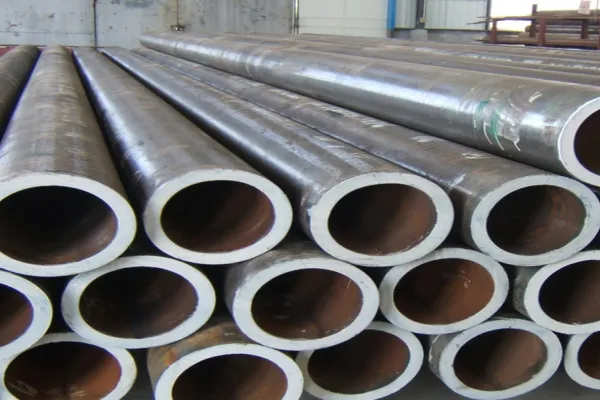ASTM A105 is one of the most widely used forged carbon steels for piping components in industrial applications. Known for its strength, versatility, and cost-effectiveness, it plays a key role in the oil & gas, petrochemical, power generation, and shipbuilding sectors.This guide covers everything you need to know about ASTM A105—its chemical and mechanical properties, applications, comparison with similar grades, and tips for sourcing quality products.
What is ASTM A105?
ASTM A105 is a standard specification for forged carbon steel piping components used in pressure systems at ambient- and high-temperature service conditions. It primarily includes forged fittings, flanges, valves, and parts for pressure vessels. Issued by ASTM International, this specification applies to carbon steel materials that are forged and heat treated to meet demanding performance conditions.
A105 round steel is the American ASTM A105/A105M standard "Carbon Steel Forgings for Pipeline Components". A represents ordinary carbon structural steel. It is widely used in the manufacture and production of high-pressure vessels and petrochemical pipe fittings, valves, and flanges. Because this standard only stipulates one type of carbon steel forgings, A105 is also considered a forged carbon steel grade. A105 is a low-carbon steel forging, similar to Sch 20 steel pipe. There are two standards, one is the American standard "ASTMA105/A105M Carbon Steel Forgings for Pipeline Components", and the other is the Chinese standard "GB/T12228-2006 Technical Conditions for Carbon Steel Forgings for General Valves".

Chemical Composition of ASTM A105
The strength and weldability of A105 come from its carefully balanced chemical composition. Here’s a typical breakdown:
|
Element
|
Composition (%)
|
|
Carbon (C)
|
≤ 0.35
|
|
Manganese (Mn)
|
0.60 – 1.05
|
|
Phosphorus (P)
|
≤ 0.035
|
|
Sulfur (S)
|
≤ 0.040
|
|
Silicon (Si)
|
0.10 – 0.35
|
|
Copper (Cu)
|
≤ 0.40
|
|
Nickel (Ni)
|
≤ 0.40
|
|
Chromium (Cr)
|
≤ 0.30
|
|
Molybdenum (Mo)
|
≤ 0.12
|
These values may vary slightly depending on the manufacturer, but all must conform to ASTM A105/A105M standards.
Mechanical Properties of ASTM A105
ASTM A105 offers excellent mechanical strength for high-stress and pressure conditions. Below are typical values:
|
Property
|
Value
|
|
Tensile strength (psi) min
|
70,000 psi
|
|
Yield strength (psi) min
|
36,000 psi
|
|
Elongation in 2″ (%) min
|
22%
|
|
Reduction of area (%) min
|
30%
|
|
Brinell Hardness (BHN) max
|
187
|
Heat Treatment Requirements
ASTM A105 components may be supplied in a normalized, normalized and tempered, or quenched and tempered condition.
Heat treatment is required for components with section thickness >4 inches.
Normalizing is often applied to improve mechanical consistency and grain refinement.
In some cases, stress relieving may be performed after machining or welding to minimize residual stresses.
Common Applications of ASTM A105
Due to its strength and availability, A105 carbon steel is widely used in:
Forged flanges (weld neck, blind, slip-on, socket weld)
Forged fittings (elbows, tees, reducers)
Valves and valve bodies
Pressure vessel nozzles
Pump and compressor parts
These components are essential in pipelines for oil & gas, water systems, petrochemical plants, and energy infrastructure.
Certifications & Standards of ASTM A105
ASTM A105 materials are generally manufactured in accordance with:
ASME B16.5 (for pipe flanges)
NACE MR0175/ISO 15156 (for sour service in oil and gas)
EN 10204 3.1 / 3.2 MTCs (mill test certificates)
NDT: Ultrasonic, magnetic particle, or dye penetrant inspection where required
Ensure your supplier offers traceability and certification for every batch to meet your quality assurance requirements.
A105 vs. A105N: What’s the Difference?
Although A105 and A105N are chemically identical, the distinction lies in the heat treatment condition. The “N” in A105N stands for normalized, meaning the material has undergone a heat treatment process to refine grain structure and enhance mechanical uniformity.
In fact, ASTM A105 allows supplementary requirements based on service conditions. The order specification may include suffixes to denote the heat treatment method:
A – Annealed
N – Normalized
NT – Normalized and Tempered
QT – Quenched and Tempered
So while A105 and A105N share the same chemical composition, they serve different purposes in practice depending on the operating environment, such as high-temperature or corrosive conditions that require greater structural stability.
Typical Applications of ASTM A105
ASTM A105 carbon steel is commonly used in the manufacture of:
Flanges (weld neck, slip-on, socket weld, blind)
High-pressure vessel components
Its mechanical properties make it especially well-suited for both high-temperature and high-pressure environments.






 English
English Español
Español بالعربية
بالعربية











 Phone :
Phone :  Whatsapp :
Whatsapp :  Email :
Email : 


